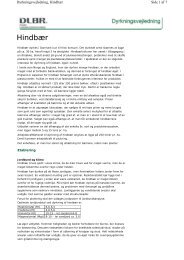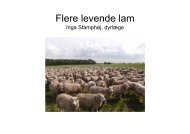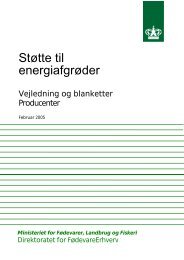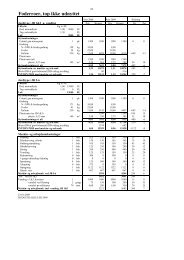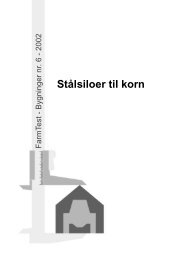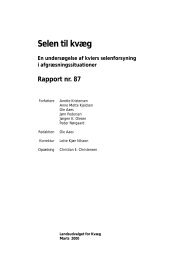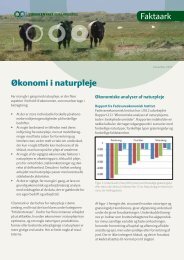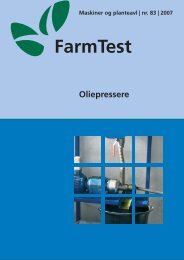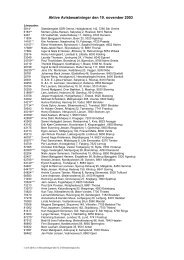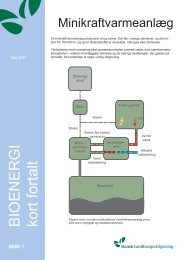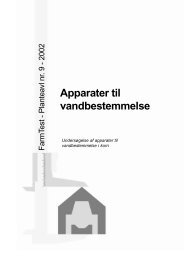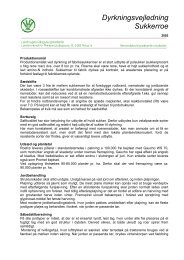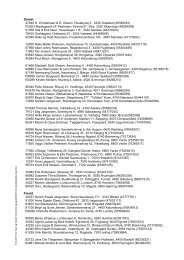randzoner - LandbrugsInfo
randzoner - LandbrugsInfo
randzoner - LandbrugsInfo
You also want an ePaper? Increase the reach of your titles
YUMPU automatically turns print PDFs into web optimized ePapers that Google loves.
5. FINDINGS: BUFFERS, LANDSCAPE PERCEPTIONS AND MANAGEMENT<br />
5.1. Landscape perceptions<br />
Structured, open landscapes with hedges and small woodlands are appealing to most people: mixed deciduous trees<br />
are commonly associated with ‘nature’ and there is a preference for ‘peaceful’ landscapes. Peaceful landscapes are<br />
never wilderness, but managed in a non-obvious manner, either infrequently or non-mechanized like short rotation<br />
forestry, old forest grazing areas or extensively used meadows [97,98]. Buffer strips usually resemble natural structural<br />
landscape elements, are managed extensively and may thus meet these criteria of acceptability for the wider public.<br />
Gradual implementation may not even be noticed by most people as the agricultural landscape changes constantly:<br />
Kristensen et al. [99] found that 8.4% of a 5000 ha agricultural area in southern Denmark underwent land use change<br />
over a period of 5 years, including removal of 14 km of shelterbelts and establishment of 20 km new shelterbelts.<br />
5.2. Farmers’ decision making regarding landscape management<br />
On the one hand, even though the linkages between agricultural practices and coastal water quality seem obvious<br />
when viewed from an ecosystem perspective, these linkages are not commonly recognized by land managers [100].<br />
On the other hand, many farmers may be interested in the development of new ways of land management, especially if<br />
they deal with cost effective ways of preserving their resource base like maintaining soil fertility and minimising erosion<br />
[101]. The relationship between farm economics and landscape management is also rarely straightforward. A choice<br />
experiment study on energy crops in Sweden revealed that although willow growing would yield the highest income, it<br />
would not provide farmers with maximum utility as other factors like landscape impact and crop characteristics played<br />
an important role [102]. Also, because the farm and the farming landscape are an expression of the farmer’s and his<br />
family’s identity [103], economics alone is not able to explain all aspects of farm management. Battershill and Gilg [104]<br />
illustrate this by the finding that the same policy framework may have very different effects depending on the farmer:<br />
some farmers in their study on the uptake of environmentally friendly farming practices described Common Agricultural<br />
Policy (CAP), local or regional regulations, obligatory set-aside and general financial constraints as hindering the<br />
development, others as helping it. Thus, structural considerations are often not as important as attitudes and beliefs, as<br />
shown by farmers under financial pressure who intensify production while others in the same situation continue to<br />
extensify due to attitudinal commitment.<br />
Regardless of the level of diversification on a farm, most farmers are interested in new land management practices<br />
when they hear of them, making research into farming systems and dissemination of knowledge in the research<br />
process a driver of land use change in itself [105]. Highly visible changes in landscape management practices that will<br />
alter the landscape mosaic (e.g. like installing shelterbelts and buffer strips on a larger scale) often require a local<br />
successful example set by a respected farmer [106]. ‘Successful’ in this context rarely refers to economic success but<br />
to a display of farming skill: Burton [103] describes farmers gauging each other’s activities by the regularity of<br />
landscape features they produce, general appearance of crops or livestock and increases in yield; the latter more as a<br />
source of personal pride than for financial reasons. From this perspective, profitability is less important for a farmer’s<br />
standing in the farming community than tidiness of the farm appearance. Regular landscapes tell a generation<br />
spanning success-story to farmers and are highly symbolic environments on a par with their economic value. The<br />
status of a whole farming family may thus change when new practices are being adopted that change the landscape<br />
appearance.<br />
Risk, effectiveness, time demand and the professional challenge associated with new land management and<br />
conservation practices can be equally or more important than economics [107]. Rigid measures, for example agrienvironmental<br />
schemes that only require compliance [108], are of little interest to those farmers who have a focus on<br />
rational, efficient production and want to display ‘good farming practice’ that is measurable in things like straightness of<br />
tramlines, crop health or absence of weeds [109].<br />
6. SYNTHESIS: DESIGNING ENERGY LANDSCAPES WITH BUFFERS FOR BIOMASS<br />
Vegetated buffer zones will reduce the losses of nutrients and pesticides from agricultural land and may help to<br />
manage the nutrient and water cycles, mitigate flooding, enhance carbon sequestration, mitigate greenhouse gas<br />
emissions through fossil fuel substitution and play a role in enabling a net energy production from agriculture [14].<br />
Thereby, buffers for biomass in temperate climate agricultural landscapes have a large potential for sustainable<br />
production of forage, fodder, biomass for bioenergy and sometimes timber. Based on the findings from the literature<br />
review in the previous sections, we suggest the implementation of energy landscapes with three-zoned buffers for<br />
biomass, as described in the following:<br />
6.1. Three-zoned buffers for biomass (based on Schultz et al., [43])<br />
As the most suitable buffer design, we suggest a three-zone structure consisting of a grass strip along the arable field<br />
or pasture, a zone with shrubs, short rotation forestry (SRF) or short rotation coppice (SRC), and a third zone along the<br />
lower edge or stream bank consisting of permanent and largely unmanaged woody vegetation.<br />
68



